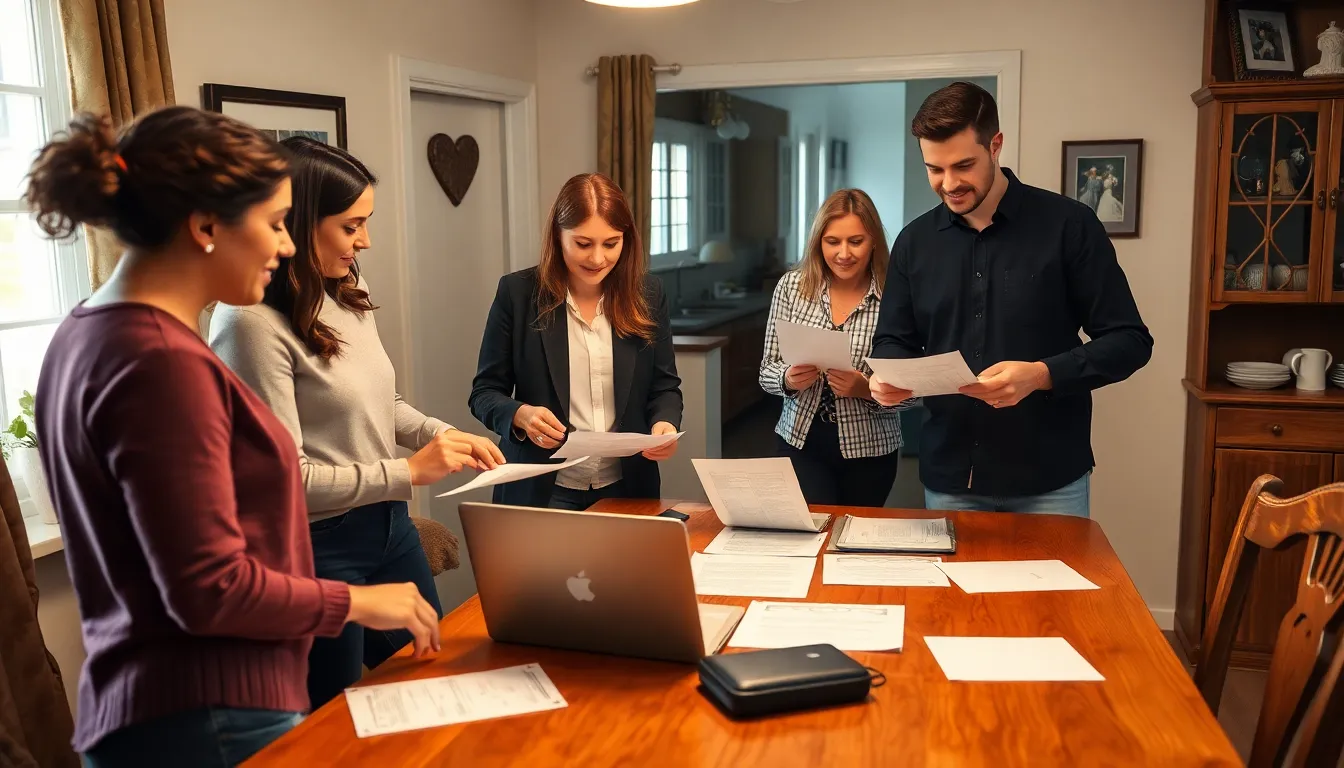Table of Contents
ToggleBuying a home can feel like a rollercoaster ride—thrilling yet nerve-wracking. As the finish line approaches, the mortgage closing process can seem like the final loop-de-loop that leaves buyers feeling dizzy. But don’t worry; it’s not as scary as it sounds. In fact, it’s your ticket to homeownership, complete with all the paperwork and a few surprises that might make you chuckle.
Overview of Mortgage Closing Process
Mortgage closing involves several key steps that finalize a home purchase. This process typically occurs after a buyer secures financing and completes necessary inspections. Buyers should expect to review various documents during closing, including the loan agreement and title information.
Critical steps include a title search to ensure there are no liens on the property. A closing disclosure outlines final loan terms and costs. This document varies from the loan estimate provided earlier, so careful scrutiny is essential. Verification of personal information also occurs, confirming identity and financial details.
Participants in the process often include the buyer, lender, real estate agent, and a closing agent or attorney. The closing agent facilitates the meeting where transaction documents are signed. Timing can vary, but most closings take place within 30-60 days after an offer acceptance.
Buyers may encounter additional costs at this stage. The closing costs typically range from 2% to 5% of the loan amount. Expenses include appraisal fees, title insurance, and attorney fees. Understanding these costs helps buyers budget effectively.
Signing occurs in a designated location, often at a title company or attorney’s office. Upon signing, buyers pay the required closing costs, finalizing the sale. Transfer of property ownership happens once all documents are executed and funds disbursed.
The mortgage closing process, despite its complexity, culminates in homeownership. Maintaining organization throughout this procedure eases potential stress. Being prepared with required documents and a clear understanding of the steps involved makes the experience smoother.
Steps Involved in Mortgage Closing
The mortgage closing process includes several important steps that guide homebuyers to successful ownership. Each phase addresses specific tasks and requirements.
Preparing for Closing
Preparation sets the foundation for a smooth closing. Buyers should gather necessary financial documents, such as pay stubs, tax returns, and bank statements. Scheduling the closing date with the lender and other parties confirms availability and readiness. It’s important to communicate any necessary changes during this stage. Each participant should understand their roles, ensuring everyone collaborates effectively.
Document Review
Document review ensures clarity and understanding of the loan terms. Buyers must carefully examine the Closing Disclosure, which outlines loan details and all closing costs. Comparison with the Loan Estimate helps identify any discrepancies in fees or terms. Essential documents like the title, mortgage agreement, and any additional disclosures warrant careful scrutiny. Asking questions about unclear sections promotes awareness and reduces future complications.
Final Walkthrough
The final walkthrough serves as a vital last check before closing. Buyers should assess the property’s condition and confirm that any agreed-upon repairs were made. Bringing a checklist of observed issues can guide this inspection. Timing is crucial; a walkthrough usually occurs 24 hours before closing. Ensuring all fixtures, appliances, and systems function as expected can prevent surprises. Addressing concerns at this stage allows for resolution prior to signing documents.
Key Parties Involved
Several parties play crucial roles in the mortgage closing process, each contributing to a successful transaction.
The Role of the Lender
Lenders provide the necessary funds for home purchases. They evaluate a buyer’s financial health, including credit scores and income, to determine loan eligibility. Once approved, lenders issue the closing disclosure, detailing final terms and costs. Communication with borrowers is key, as it clarifies any questions regarding loan terms. Maintaining transparency fosters a smoother experience for buyers during this complex process.
The Role of the Title Company
Title companies verify property ownership and ensure clear titles. They conduct necessary searches to identify any liens or claims against the property. Presenting title insurance protects buyers and lenders from future legal issues. A title agent prepares documentation for closing, facilitating the transfer of ownership. Their expertise is essential for confirming that all paperwork complies with state regulations.
The Role of the Real Estate Agent
Real estate agents guide buyers through the home-buying journey. They provide valuable market insights, help negotiate offers, and assist in navigating the closing process. Agents coordinate communication between all parties involved, including lenders and title companies. Their support during the final walkthrough ensures buyers address any concerns before completing the purchase. Ultimately, agents streamline transactions, making the experience more manageable for buyers.
Common Challenges During Closing
Navigating the mortgage closing process often presents several challenges that can complicate home purchases. Missing documentation frequently becomes a roadblock, as all necessary paperwork must be prepared and submitted on time. Buyers may encounter discrepancies between the Closing Disclosure and Loan Estimate, which can lead to confusion and delays.
Unexpected costs can arise during closing, adding financial strain. These costs often range from 2% to 5% of the loan amount, covering items like appraisal fees and title insurance. Buyers should prepare for these expenses to avoid budget surprises.
Issues with title searches can also complicate the process. A title company must verify property ownership, ensuring no liens exist. Delays in clearing title issues can postpone the entire closing timeline, creating frustration for all parties involved.
Miscommunication among participants may lead to additional hurdles. Real estate agents, lenders, and closing agents must effectively communicate to align their efforts. Buyers might feel overwhelmed by the complex interactions, but asking questions can clarify confusing points.
Last-minute repairs or conditions agreed upon during negotiations may remain unaddressed, creating conflicts during the final walkthrough. This stage ensures that the property’s condition aligns with what was promised. If problems arise, buyers may experience anxiety just before closing.
Time constraints often add pressure to the closing process. Typically, closings occur within 30-60 days after an offer is accepted, leading to a race against the clock. Staying organized and proactive helps mitigate potential challenges, enhancing the overall experience.
Tips for a Smooth Closing Experience
Staying organized significantly eases the closing process. Buyers should create a checklist of necessary documents, such as pay stubs, tax returns, and bank statements. Confirming the closing date with all parties helps prevent last-minute surprises.
Reviewing documentation in detail reduces potential issues. Pay special attention to the Closing Disclosure, ensuring that it aligns with the Loan Estimate. Identifying discrepancies early can prevent complications.
Conducting the final walkthrough prior to closing allows buyers to verify the property’s condition. Inspecting that all requested repairs are completed and that the property is in satisfactory shape ensures no surprises during sign-off.
Communicating openly with your real estate agent fosters clarity. They can address any concerns relating to repairs or additional costs, ensuring a smoother transaction. A proactive approach strengthens collaboration among participants.
Understanding all fees associated with closing helps avoid unexpected financial strain. Costs typically range from 2% to 5% of the loan amount, encompassing appraisal fees and title insurance. Confirming these expenses in advance keeps budgeting accurate.
Anticipating challenges enhances preparedness. Missing documentation, title search issues, or miscommunication can complicate the process. Recognizing potential obstacles allows for strategic solutions before they arise.
Keeping a flexible mindset during closing can mitigate stress. Last-minute changes sometimes occur, and adaptability can lead to more positive outcomes. Maintain a problem-solving attitude through the entire process.
Ensuring all parties are on the same page ultimately drives smooth transactions. Engaging all relevant stakeholders—from lenders to closing agents—supports clear communication. This connection fosters a cohesive experience and successful transition to homeownership.
Conclusion
Navigating the mortgage closing process can be daunting but it’s an essential step toward homeownership. By staying organized and proactive buyers can minimize stress and ensure a smoother experience. Understanding the roles of all parties involved and carefully reviewing documents will help avoid surprises. With preparation and clear communication buyers can confidently approach closing day knowing they are one step closer to owning their new home. Embracing this journey with a positive mindset can transform the closing process into a fulfilling milestone in their home-buying adventure.






